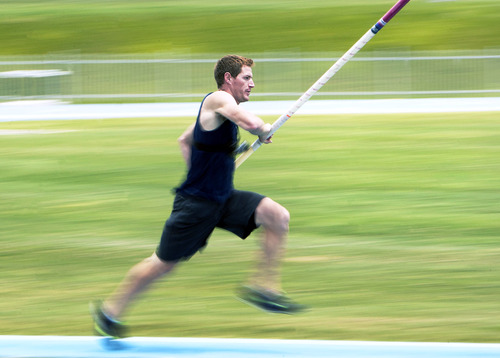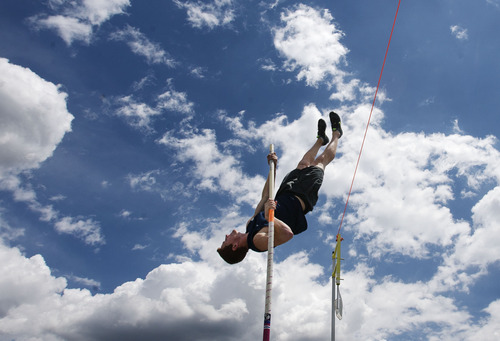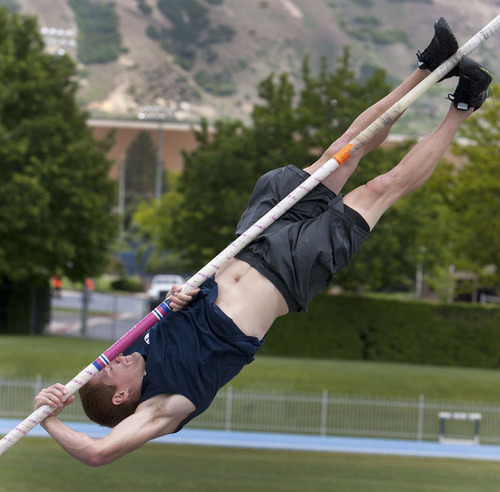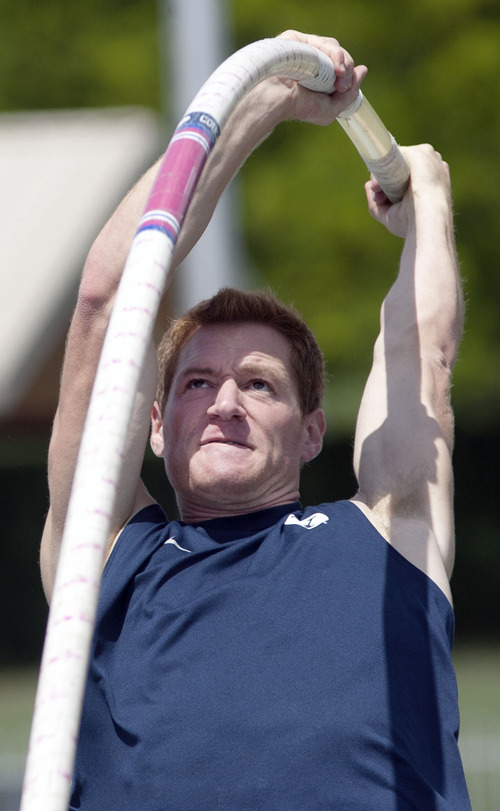This is an archived article that was published on sltrib.com in 2013, and information in the article may be outdated. It is provided only for personal research purposes and may not be reprinted.
Like almost every other kid from Texas, Victor Weirich wanted to play football.
He did not want to do what he ended up doing: compete in a sport that few kids in Texas wanted to pursue, that few kids anywhere ever even try, an offbeat, kind of weird sport that has been around for centuries, but that almost no one fully comprehends.
He did not want to sprint down a 120-foot path with a five-pound, 17-foot fiberglass or carbon-fiber pole, plant the pole, transferring kinetic energy into potential energy at the launch point, swinging up, up, up and turning over a bar perched 18 feet in the air and then floating back to the pit, hoping the bar stays right where it is.
No. He wanted to catch touchdown passes.
"I wanted to play football so much," he says.
Instead, he transfers energy.
And he does it better than all but a handful of college athletes, having qualified for next week's NCAA track championships in Eugene, Ore., by tying for first in the West preliminaries. The BYU senior also qualified in 2011, when he finished fourth overall. Although his personal-best jump is 18 feet, 2 inches, and he predicts it will take a leap of 18 feet, 8 inches to win nationals, Weirich believes that, based on his performances in practice, that height "is achievable for me."
If it is, it will mark an accomplishment steeped in a combination of athleticism and technical mastery unlike any other sport.
"Quirky" is the word Weirich uses to describe pole vaulting: "It took 10 years for me to understand it. I'm 25 now, and I'm just barely starting to understand it all."
He says people are curious about his specialty. "They always have questions, like: 'Have you broken any poles? Have you ever been injured? How high have you gone?' They talk about the YouTube video where the pole breaks, or the guy goes over the bar and lands on the pole and it shoots him off in another direction. And people love the hot female pole vaulters …"
On that last one, so does Weirich. He's dating one, he says — a teammate at BYU.
Here's what you need to know, and a little of what you don't, about pole vaulting: The sport traces its roots hundreds of years back to countrymen in England and the Netherlands flinging themselves over marshy bogs and canals as a practical means of getting around. Long before that, the ancient Greeks made a sport of it. It was included in the modern Olympic Games in 1896. Women started competing in the event at the Olympics in 2000.
At first the poles were made of bamboo, and then aluminum. Now, they are sophisticated blends of high-tech fibers. Weirich uses eight different poles in his training and competitions, each of which costs around $700.
He started competing in the pole vault in seventh grade in his hometown of Fredericksburg, Texas. His older brothers did it, so he slowly was drafted into the event. He played football, too, but was better at this other thing.
"I had no choice," he says. "I was actually pretty good."
The technical aspects of the sport were overwhelming at the start, and beyond. See if you can keep this straight:
"You need athletic ability. You have to be fast, strong and coordinated," Weirich says. "I had to run with the pole — and still be fast — and not look all goofy and what-not. When you're running with the pole and lowering it, because you're holding it at one end, it gets heavier. You can't miss the box. Then, it's like doing a layup, you have your arm stretched out and you jump, driving with your knee, jumping as hard and high as you can, moving up and forward."
That's the beginning.
"The poles are awesome how they work," he says. "In the middle is the sail piece where the pole bends. It moves you forward and picks you up. There's a lot of physics — you're transferring energy. Next thing, you move your arms, pushing against the pole, like you're rowing a boat, creating more energy into the pole. At the same time you're rowing, you're swinging your trail leg to catch up with your other leg. You go upside down, collapsing your less-dominant arm. When you're upside-down, you're pulling your arms to your chest, creating more energy. You pull through and start turning so you can pike up and over the bar. You push off the pole and then float down."
Hoping neither to bump the bar or break your neck.
There's a whole lot more — double pendulum motions, inversions, axis spins — but we've already done enough damage here.
"You have to have good body control," Weirich says. "A lot of women in pole vaulting used to be gymnasts. You need great body awareness."
And an advanced degree in Quantum Consciousness.
As an All-American, Weirich seems to have figured it out better than most. After nationals, he hopes to help other vaulters at BYU master their complicated craft, and also continue his own training to pursue pole vaulting professionally, at least for a couple of years.
"It takes time to learn it," he says. "You have to be patient. That's the biggest thing. I'm just a regular guy."
A regular guy doing an irregular thing.
Gordon Monson hosts "The Big Show" with Spence Checketts weekdays from 3-7 p.m. on 97.5 FM, 1280 AM and 960 AM The Zone. —
NCAA Championships
O June 5-8
At Eugene, Ore. —
Victor Weirich file
Age • 25. School • BYU. Class • senior.
Event • Pole vault
Hometown • Fredericksburg, Texas
Personal best • 18 feet, 2 inches
Highlights • Finished fourth at NCAA outdoor championships in 2011. ... Qualified for NCAA indoor championships in each of the past three seasons. ... First-team All-American once. ... Second-team All-American twice.













